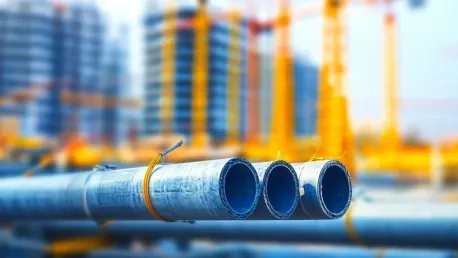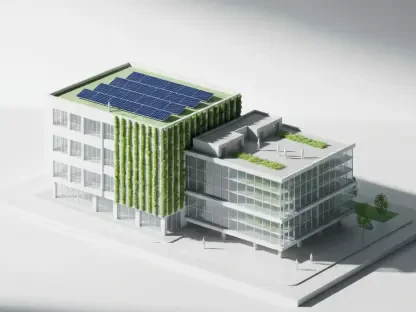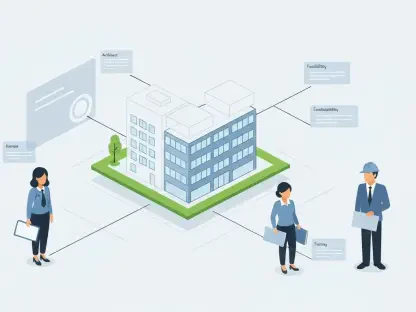The UAE construction equipment market is poised for substantial growth, driven by aggressive investments in renewable energy and infrastructure projects. According to Arizton’s latest research, the market is expected to see a significant increase in sales, reaching 28.5 thousand units by 2029, with a revenue surge of $1.27 billion over the next six years. This growth is underpinned by a projected Compound Annual Growth Rate (CAGR) of 5.70% from 2023 to 2029. Various factors come into play, ensuring this significant expansion, which addresses the increasing demand for construction machinery, sophisticated projects, and the UAE’s ambitious environmental commitments.
Renewable Energy Investments
A major driver of this growth is the UAE’s commitment to renewable energy, particularly in light of the country’s ambitious goal to achieve net-zero emissions by 2050. This commitment is fueling a surge in construction projects related to renewable energy, such as energy storage, solar farms, and wind power installations. These projects, in turn, drive up the demand for advanced construction equipment like excavators, cranes, and site preparation machinery. As these projects grow in scale and complexity, the need for cutting-edge machinery that provides efficiency and sustainability becomes more critical, further stimulating market growth.
The first half of 2024 saw a record $30 million in funding for UAE energy startups, surpassing the $24 million raised in 2023. This funding is largely channeled towards energy storage and battery technologies (33.3%) and solar energy firms (25%). This financial momentum reflects a broader push towards renewable energy projects, which directly impacts the demand for construction equipment. As these startups advance their projects, their need for reliable and efficient construction machinery becomes evident, catering to a market that is continuously evolving with new technology and higher standards of energy efficiency.
Green Bonds and Clean Energy Certificates
Established entities are also making significant financial moves. In July 2024, Masdar issued a $1 billion green bond to fund new renewable energy projects. The bond’s tremendous success, being 4.6 times oversubscribed, indicates strong financial backing for such projects. Moreover, the introduction of Clean Energy Certificates (CECs) by the Emirates Water and Electricity Company (EWEC), especially for wind power, necessitates the development of new infrastructure, thus driving demand for various construction equipment. These financial instruments and initiatives are not only supporting the growth of renewable energy projects but also ensuring a steady demand for construction machinery. These innovative funding mechanisms are crucial in maintaining the pace at which renewable energy projects are developed, driving the need for sophisticated equipment.
The issuance of green bonds and CECs highlights the UAE’s strategic approach to financing its ambitious energy goals, further solidifying the market’s growth prospects. Green bonds, in particular, serve as an attractive investment vehicle for both local and international investors, funneling resources into large-scale infrastructure and energy projects. Clean Energy Certificates provide proof that the energy being produced and sold is generated from renewable sources, encouraging companies to invest in new renewable energy projects. These initiatives underline the country’s commitment to a sustainable future, which in turn propels the demand for advanced construction equipment tailored for such innovative projects.
Key Market Segments
The construction equipment market in the UAE is segmented by type, including earthmoving equipment, road construction equipment, material handling equipment, and other construction equipment. Earthmoving equipment encompasses excavators, backhoe loaders, wheeled loaders, and other machinery like bulldozers, trenchers, and motor graders. Road construction equipment includes road rollers and asphalt pavers, while material handling equipment covers cranes, forklifts, telescopic handlers, and aerial platforms such as articulated and telescopic boom lifts and scissor lifts. This segmentation provides a nuanced understanding of the various types of machinery employed in different construction activities, each crucial for meeting the diverse needs of multiple sectors.
Other construction equipment involves dumpers, tippers, concrete mixers, and concrete pump trucks. This segmentation provides a detailed framework for understanding the distribution and application of construction machinery across different sectors, ensuring that the market can meet the diverse needs of its end users. Each category of equipment plays a vital role in different stages of construction projects, from the initial site preparation to the final stages of building and infrastructure development. By catering to various specific requirements, the market ensures a comprehensive supply of machinery that supports the seamless execution of complex projects across the UAE.
End Users
The end users of construction equipment span across various sectors such as construction, mining, manufacturing, and others. The construction sector covers buildings and infrastructure projects, while the mining sector involves the extraction of minerals. The manufacturing sector includes the production of goods and materials, and other sectors encompass power generation, utilities (municipal corporations), oil & gas, cargo handling, waste management, and power generation plants. This diverse range of end users highlights the broad applicability of construction equipment in the UAE, ensuring that the market can cater to a wide array of industry needs.
The construction sector remains a dominant player, continuously expanding with new buildings and infrastructure projects. Meanwhile, the mining industry requires specialized machinery to maintain efficient extraction processes. The manufacturing sector’s growth further drives demand for construction machines essential for facility expansion and production line setup. In addition to these, sectors like power generation and waste management also contribute significantly to the market, requiring advanced equipment for various types of operational needs. The multifaceted demand across these sectors showcases the integral role of construction machinery in supporting the UAE’s overall development and economic growth.
Notable Vendors
Key vendors dominating the market include Caterpillar, Komatsu, Volvo Construction Equipment, Hitachi Construction Machinery, Liebherr, SANY, XCMG (Xuzhou Construction Machinery Group Co. Ltd.), and others. Additionally, local distributors such as Abdulla Saeedi General Trading LLC, Anwar Al Quds Machinery, Kanoo Machinery, and FAMCO play a significant role. These vendors are pivotal in supplying advanced machinery that meets the rising demand. Their involvement in both the supply of equipment and the funding of renewable energy projects underscores their importance in the market’s growth trajectory. The presence of these major players ensures that the market remains competitive and innovative, continually evolving to meet the needs of diverse construction projects.
These companies are committed to providing high-quality machinery that not only meets the current demands but also anticipates future needs. They invest heavily in research and development to create more efficient, environmentally friendly construction equipment. The local distributors, on the other hand, ensure that these advanced machines are accessible to the UAE market, providing essential support and services to construction firms across the country. The synergy between international manufacturers and local distributors strengthens the supply chain, ensuring that the market is well-equipped to handle the growing demands.
Hydrogen Strategy
The UAE’s National Hydrogen Strategy, approved in November 2023, aims to produce 15 million tonnes of green hydrogen annually by 2050. This strategy positions the UAE as a leader in hydrogen production and export, aligning with sustainability goals. The development of a hydrogen economy could increase the demand for hydrogen-fueled construction equipment, particularly in green energy and infrastructure projects. This strategic move towards hydrogen production is expected to create new opportunities for the construction equipment market. As the UAE continues to invest in hydrogen infrastructure, the demand for specialized machinery will rise, further driving market growth.
The push towards hydrogen as a clean energy source is not just a local initiative but a global shift towards sustainable energy solutions. By positioning itself as a leader in hydrogen production, the UAE is setting a precedent for innovation and sustainability in the energy sector. This move is likely to attract significant international investments and partnerships, further boosting the demand for specialized construction equipment. The construction industry will need to adapt to new requirements brought about by hydrogen projects, such as specific types of machinery for hydrogen plants and infrastructure, ensuring that the market remains dynamic and forward-looking.
LNG Projects
The demand for Liquefied Natural Gas (LNG) production projects is growing. Global demand for gas is expected to rise by 14% by 2030, and the UAE is positioning itself to meet this demand. The Abu Dhabi National Oil Company (ADNOC) plans to expand the UAE’s LNG capacity from 77 million tonnes to 126 million tonnes per year by 2027. In July 2024, Shell Overseas Holdings Limited invested in ADNOC’s Ruwais LNG project, taking a 10% stake. The project includes two LNG liquefaction trains with a combined capacity of 9.6 million metric tonnes per annum. This expansion in LNG capacity will drive the demand for construction equipment, particularly cranes. The development of new LNG facilities requires extensive use of high-end machinery, ensuring that these projects can be completed efficiently and on time.
The rise in LNG production aligns with the global trend towards natural gas as a cleaner alternative to other fossil fuels. As more countries commit to reducing their carbon footprints, the demand for LNG is set to increase, making it a lucrative sector for investment. The construction equipment market stands to benefit substantially from this trend, as new LNG facilities and infrastructure projects will require advanced machinery. Companies involved in these projects will need reliable and efficient equipment to handle the unique challenges of LNG production, driving the continuous growth of the construction equipment market in the UAE.
Market Analysis Findings
The Arizton market research report consolidates insights for various stakeholders, including industry players, investors, researchers, consultants, and business strategists. It offers a comprehensive analysis of the market size, sales forecast, growth rate, key players, trends, and opportunities. The market size is expected to grow from 20.4 thousand units in 2023 to 28.5 thousand units in 2029, with revenue hitting $1.27 billion. The projected CAGR of 5.70% indicates substantial growth potential, highlighting the market’s promising trajectory. Major market players are involved in both the supply of equipment and the funding of renewable energy projects, ensuring a robust ecosystem for sustained growth.
The report’s detailed analysis provides valuable insights into the market dynamics and future prospects, offering a clear view of the opportunities and challenges ahead. Stakeholders can use this information to make informed decisions, capitalize on emerging trends, and strategically position themselves in the market. Trends like the surge in renewable energy projects and strategic funding initiatives are opening new opportunities for growth in the construction equipment market. These developments underscore the importance of staying ahead of industry trends and adapting to the fast-evolving market landscape.
Summary
The UAE construction equipment market is set to experience substantial growth due to significant investments in renewable energy and infrastructure projects. Arizton’s latest research indicates that the market is anticipated to see a notable rise in sales, reaching 28.5 thousand units by 2029, with revenue increasing to $1.27 billion over the next six years. This expansion is backed by a projected Compound Annual Growth Rate (CAGR) of 5.70% from 2023 to 2029. Several factors contribute to this impressive growth. The increasing demand for construction machinery plays a pivotal role, as does the ongoing development of sophisticated construction projects. Additionally, the UAE’s ambitious environmental goals are driving the need for advanced and efficient construction equipment to support their renewable energy initiatives.
The construction sector in the UAE is thriving due to these aggressive investments and large-scale projects. The focus on sustainability and modern infrastructure aligns with the UAE’s vision for a greener and more technologically advanced future. As a result, the market for construction equipment is not only growing but also evolving to meet the high standards set by new environmental regulations and projects’ demands. The combination of these elements ensures a robust growth trajectory for the construction equipment market in the UAE, positioning it for a prosperous future as it adapts to meet both current and future needs.









